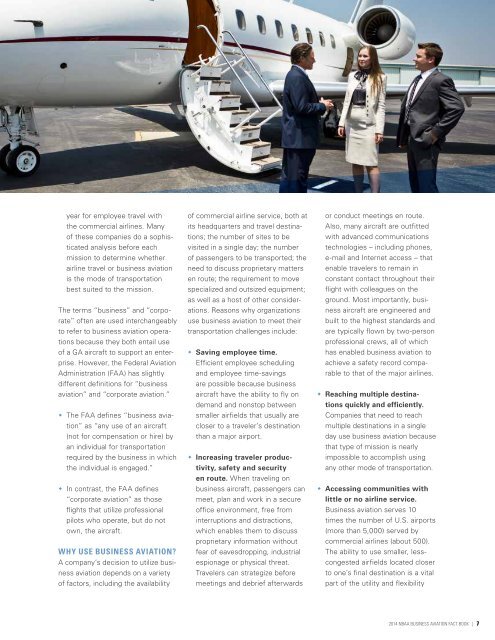business-aviation-fact-book-2014
business-aviation-fact-book-2014
business-aviation-fact-book-2014
You also want an ePaper? Increase the reach of your titles
YUMPU automatically turns print PDFs into web optimized ePapers that Google loves.
year for employee travel with<br />
the commercial airlines. Many<br />
of these companies do a sophisticated<br />
analysis before each<br />
mission to determine whether<br />
airline travel or <strong>business</strong> <strong>aviation</strong><br />
is the mode of transportation<br />
best suited to the mission.<br />
The terms “<strong>business</strong>” and “corporate”<br />
often are used interchangeably<br />
to refer to <strong>business</strong> <strong>aviation</strong> operations<br />
because they both entail use<br />
of a GA aircraft to support an enterprise.<br />
However, the Federal Aviation<br />
Administration (FAA) has slightly<br />
different definitions for “<strong>business</strong><br />
<strong>aviation</strong>” and “corporate <strong>aviation</strong>.”<br />
• The FAA defines “<strong>business</strong> <strong>aviation</strong>”<br />
as “any use of an aircraft<br />
(not for compensation or hire) by<br />
an individual for transportation<br />
required by the <strong>business</strong> in which<br />
the individual is engaged.”<br />
• In contrast, the FAA defines<br />
“corporate <strong>aviation</strong>” as those<br />
flights that utilize professional<br />
pilots who operate, but do not<br />
own, the aircraft.<br />
Why Use Business Aviation?<br />
A company’s decision to utilize <strong>business</strong><br />
<strong>aviation</strong> depends on a variety<br />
of <strong>fact</strong>ors, including the availability<br />
of commercial airline service, both at<br />
its headquarters and travel destinations;<br />
the number of sites to be<br />
visited in a single day; the number<br />
of passengers to be transported; the<br />
need to discuss proprietary matters<br />
en route; the requirement to move<br />
specialized and outsized equipment;<br />
as well as a host of other considerations.<br />
Reasons why organizations<br />
use <strong>business</strong> <strong>aviation</strong> to meet their<br />
transportation challenges include:<br />
• Saving employee time.<br />
Efficient employee scheduling<br />
and employee time-savings<br />
are possible because <strong>business</strong><br />
aircraft have the ability to fly on<br />
demand and nonstop between<br />
smaller airfields that usually are<br />
closer to a traveler’s destination<br />
than a major airport.<br />
• Increasing traveler productivity,<br />
safety and security<br />
en route. When traveling on<br />
<strong>business</strong> aircraft, passengers can<br />
meet, plan and work in a secure<br />
office environment, free from<br />
interruptions and distractions,<br />
which enables them to discuss<br />
proprietary information without<br />
fear of eavesdropping, industrial<br />
espionage or physical threat.<br />
Travelers can strategize before<br />
meetings and debrief afterwards<br />
or conduct meetings en route.<br />
Also, many aircraft are outfitted<br />
with advanced communications<br />
technologies – including phones,<br />
e-mail and Internet access – that<br />
enable travelers to remain in<br />
constant contact throughout their<br />
flight with colleagues on the<br />
ground. Most importantly, <strong>business</strong><br />
aircraft are engineered and<br />
built to the highest standards and<br />
are typically flown by two-person<br />
professional crews, all of which<br />
has enabled <strong>business</strong> <strong>aviation</strong> to<br />
achieve a safety record comparable<br />
to that of the major airlines.<br />
• Reaching multiple destinations<br />
quickly and efficiently.<br />
Companies that need to reach<br />
multiple destinations in a single<br />
day use <strong>business</strong> <strong>aviation</strong> because<br />
that type of mission is nearly<br />
impossible to accomplish using<br />
any other mode of transportation.<br />
• Accessing communities with<br />
little or no airline service.<br />
Business <strong>aviation</strong> serves 10<br />
times the number of U.S. airports<br />
(more than 5,000) served by<br />
commercial airlines (about 500).<br />
The ability to use smaller, lesscongested<br />
airfields located closer<br />
to one’s final destination is a vital<br />
part of the utility and flexibility<br />
<strong>2014</strong> NBAA Business Aviation Fact Book | 7


